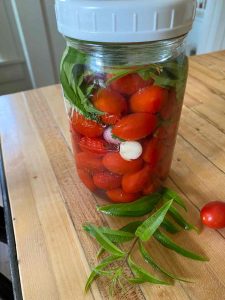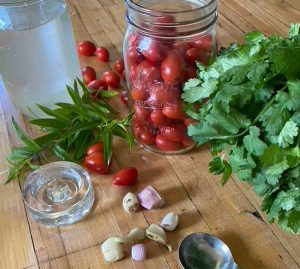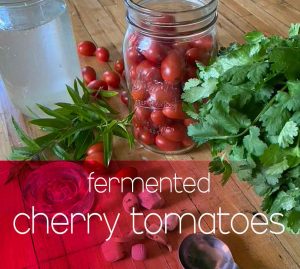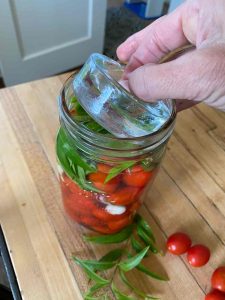Fermenting Cherry Tomatoes for Gut Health
Fermenting Cherry Tomatoes for Gut Health
Cherry tomatoes are a fun way to promote health in your gut, if you ferment them! Fermenting is also a wonderful way to use up all of those wonderful vegetables in the garden. I also have a sauerkraut recipe that uses a method called fermentation. This process is specifically is called Lacto-fermentation. You can find my recipe specifically for sauerkraut here.
(This resource talks a little more about it).
The Fermentation Process
Traditional lacto-fermentation involves submerging vegetables in a brine solution— real salt and water. There are also methods of fermenting without added salt. The salt-brine method involves two stages:
First Stage of lacto-fermentation, vegetables are submerged in a brine that is salty enough to kill off harmful bacteria. The Lactobacillus (friendly bacteria) survive this stage and begin stage two.
Second Stage of lacto-fermentation, the Lactobacillus organisms begin converting lactose and other sugars present in the food into lactic acid. This creates an acidic environment that safely preserves the vegetables – and gives lacto-fermented foods their distinctive tangy flavor. (That link has some additional wonderful fermented recipes.)
Fermentation is Different from Canning
While lacto-fermentation is a common and traditional form of pickling and preserving vegetables, it is not the same thing as canning and is not used for long-term preservation. Many fermented foods are edible for two months or more, and their flavors develop and become more acidic over time. Typically, you begin eating a fermented food once it has reached the desired level of fermentation and you finish it before the end of its “shelf life,” during which time the flavors will mature and change.
By contrast, canning involves some form of sterilization and is intended to preserve food in its canned state for long periods, often for 6 months to a year or more.
It is important to mention here, that most of the enzymes are lost during the canning process. Even though some of the nutrition may still be somewhat in the canned foods, it isn’t necessarily as nutritious in that it isn’t as usable in the body as a fermented food.
Fermenting Cherry Tomatoes and/or Other Vegetables
This is my process of fermenting vegetables (not sauerkraut):
1-3 tablespoons per quart of water to make a brine to pour over vegetables in a mason jar and allow to sit for a period of time (from 3 days to a month, depending on the vegetable.
Pack the vegetables firmly into a large jar, crock or bowl. Press the vegetables down until the liquid arises above the jar contents, about 1/4 of an inch.
Next you will apply weight to hold the vegetables down under the liquid. You can find nice jar weights here, but you could also use another type of weight if you are making any other vegetable in a crock or a bowl. Cover the jar or bowl with a clean dish towel. Alternatively, you can cover with a lid on the jar. If you use a lid, you will need to “burp” the vegetables, or unscrew the lid, every day to make sure the gases do not build up. Alternatively, you can build silicone lids that will allow the gasses to release for you. Find those here.
Fermenting Time
Depending on the vegetable you are fermenting, fermentation time may be a bit of an experiment. I’ve had success with 3 days to 14 days, depending on how sour the taste is for you. Once the fermentation is where you like it, go ahead and put a lid on it and refrigerate. You may keep the jar in the refrigerator for several months. It may continue to get a little more sour but the cooling will slow the fermentation down.
Feel free add different seasonings to your vegetable combo. Other options to add are garlic, onions, radishes or whatever vegetables you’d like to experiment with. Let me know what you think in the comments below. Enjoy!

I used use metal lid, but am trying the plastic one this time, since it is not touching the brine. Feel free to try the silicone, in the shopping list.
See my recipe for Fermented Cranberries here!
Equipment list:
Redmond Salt (my new favorite)
Lemon Verbena seeds to grow your own
Some links are affiliate links, which means I make a small commission at no extra cost to you. See more info here.
Cherry tomatoes are a fun way to promote health in your gut, if you ferment them! Fermenting is also a healthy way to use up all of those wonderful vegetables in the garden.
Ingredients
cherry tomatoes
small onions or onions chopped in small chunks
one branch of lemon verbena or small chunks of lemon (optional)
water
onions (optional)
cilantro (optional)
celery (optional)
Redmond Real salt or Himilayan Salt
Instructions
1. Dissolve 2 Tbsps of salt into a quart of water. (You may use less, but I wouldn't go under 1 Tbsp.
2. Pack cherry tomatoes, onions and lemon leaves into a jar, leaving an inch and a half of space on the top of the jar.
3. Pour brine (salt water) over the tomatoes, making sure all is covered. Use glass weights to keep the liquid covering the contents of the jar.
4. Cover with tight fitting lid and place on the cupboard in a dark spot. You can also cover it with a towel. Sometimes I cover it when I put it on the cupboard where I can see it and be reminded to do number 5.
5. "Burp" your jar every day by unscrewing the lid to release any pressure. You will see bubbles as early as day 2. I like to leave my tomatoes for 5 days on the cupboard. Alternatively, you may purchase silicone lids that will burp it for you. See shopping list above.
6. When taste is to your liking, take out weights and put into the fridge to enjoy for several months.

Prep time: 10
Cook time: 3
Total time: 10
Servings: 5
Serving size: 2-3 tomatoes
Meal type: Lunch, Dinner, Sidedish, Appetizer, Fermented, Raw
Special Equipment needed: jar, fermenting weights (optional)


